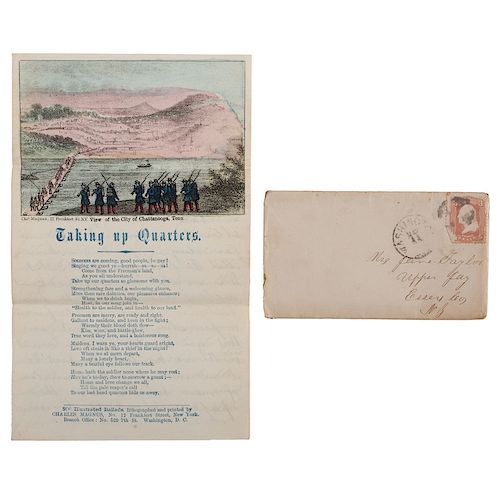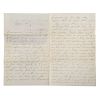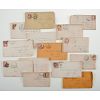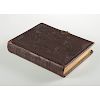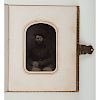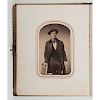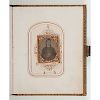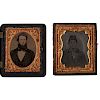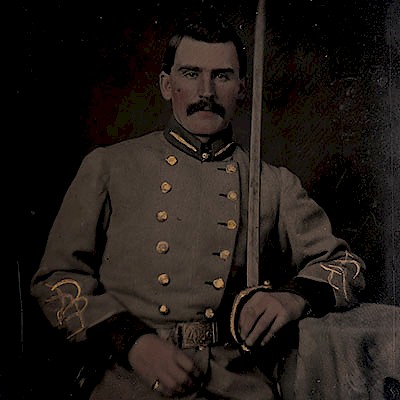Private Daniel C. Taylor, New York 46th Infantry, Civil War Archive Incl. Letters and Photographs
About Seller
6270 Este Ave.
Cincinnati , OH 45232
United States
With offices in Cincinnati, Cleveland and Denver, Cowan’s holds over 40 auctions each year, with annual sales exceeding $16M. We reach buyers around the globe, and take pride in our reputation for integrity, customer service and great results. A full-service house, Cowan’s Auctions specializes in Am...Read more
Two ways to bid:
- Leave a max absentee bid and the platform will bid on your behalf up to your maximum bid during the live auction.
- Bid live during the auction and your bids will be submitted real-time to the auctioneer.
Bid Increments
| Price | Bid Increment |
|---|---|
| $0 | $25 |
| $500 | $50 |
| $1,000 | $100 |
| $2,000 | $250 |
| $5,000 | $500 |
| $10,000 | $1,000 |
| $20,000 | $2,500 |
| $50,000 | $5,000 |
| $100,000 | $10,000 |
About Auction
Jun 22, 2018
Cowan’s American History: Premier Auction, scheduled for June 22, 2018 is comprised of early photographs, documents, manuscripts, broadsides, flags, and more dating from the Revolutionary War, the Civil War, Late Indian Wars, World War I and II and beyond. Cowan's Auctions dawnie@cowans.com
- Lot Description
Lot of 89 letters, including 53 war-dated letters. Accompanied by a brown leather photo album, 5 x 6.25 in., and two additional cased images.
Daniel Cyril Taylor (1839-1906) was born in Keene, NY, the son of Nathan Dodge Taylor and Susan Bull Taylor. The 1860 US Federal Census shows that Daniel Taylor lived at home with his parents and a large number of siblings in Jay, Essex County, NY. Daniel and his father were listed as farmers in the census. On September 2, 1864, Taylor enlisted as a private and was mustered into "C" Co, New York 46th Infantry, also known as the "Freemont Rifle Regiment." He would serve until the end of the war mustering out in Washington DC on June 3, 1865.
In 1863, Daniel Taylor married Sarah Jane Crary Taylor (1845-1926). The bulk of the war-date correspondence, 46 letters, is from Taylor to his wife and spans the term of his enlistment September 1864 through May 1865. His first letter home is dated September 11, 1864, written from Hart Island, New York Harbor. From there he travels to "Camp near Petersburg." Taylor's early letters describe his journey from Plattsburgh to Virginia, and his routine in camp. His letter of October 7, 1864, is the first to describe any combat operations following his regiment's participation in the Battle of Peebles's Farm, or Poplar Springs Church. The 46th suffered casualties in this engagement which was part of the larger Union offensive against Confederate works aimed at taking Richmond and Petersburg during the Siege of Petersburg. Taylor tells Sarah that "we had a small battle one week ago today we was on the extream left and the rebs tried to flank us and we had to run and you may guess that we took our legs for it we ran threw a small piece of corn we could hear the balls cut the leaves and some of the men fell too but not many was killed we think that the rebs got a very few prisners...about half [the regiment] lost their napsacks and some their guns. I did not loose a thing..."
In October and November Taylor remained camped near Petersburg. He was engaged primarily in the construction of breastworks, drilling, and occupying the territory that was steadily being won over from the Confederates as the Union continued its push to Petersburg. Letters throughout the fall season describe his tent, bedding, food, camp life, mail, money matters, and news from the front. His mood is typically upbeat as he knows that the fighting is more extensive and more bloody on other fronts, and he is increasingly confident that the war is drawing to a close. He writes to Sarah on November 27, 1864, "...thare is no news that I know of only that the papers talk a good deal about the war being settled they all say that the rebs are very hard up thare is a good many of the rebs that are leaving their lines and coming over to our lines and they say the same..."
In early December, Taylor's regiment marches about 15 miles to a location right outside of Petersburg. He writes his wife from "In the Pits near Petersburg" describing his situation: "we lay now on the north east side of Petersburg and in about two miles of it we lay whare the balls fly by spells so we must keep our heads down we have good brest - works and under ground houses and we have diches dug to walk in from one place to an other so if a man looks out he may be all rite ... we can hear the bells in Petersburg and can see the edge of it prety plain we can see a quite a number of steeples and one factory...." Taylor remained camped in the siege lines near Petersburg into the New Year and his letters are increasingly filled with anticipation as he notes the battles most recently won by the advancing Union armies.
The relative calm Taylor experienced in the early part of 1865 ended in March. On March 25th the 46th Regiment fended off a surprise pre-dawn Confederate offensive at the Battle of Ft. Stedman, and then as part of the Appomattox Campaign fought during the Fall of Petersburg. Taylor describes the harrowing events at Ft. Stedman to his wife saying that "they came in big and they advanced quite a piece" before he was even up, and "pretty soon the shells began to come three or four at time as long as it was dark we could see them before they had got half way here but after it began to come light then we could not see them but it was just the same." Taylor goes on to describe the Confederate retreat and the losses suffered by his regiment. In letters of April 3 and April 6, 1865, Taylor recounts the next stage of the battle as his regiment fought to end the siege and retake the coveted city of Petersburg. "We have had quite an altercation down here for a few days past you know that I told you that old Lee would have to look out well I think that he has had his hands full for a few days past & I guess that you would if you could see the works that he had been drove out of & the number of men he has lost - the papers report 12 thousand prisners." Taylor describes charging the enemy lines saying that "we made a charge on the enemies line about four o'clock whare we charged was in front of the city and there was but 2 Regs that was in the charge..." Then in his later letter tells Sarah that "... the news came back that the skirmishers had taken the first line and wanted help so we the 4 first companys of our Regt jumped over the breast-works and ran across the field like sixty in under at pretty good fire we soon was in the second entrenchment..."
Following the Fall of Petersburg and Lee's April 9 surrender at the Battle of Appomattox Court House, Taylor's regiment moved to Washington, DC. He mustered out on June 3, 1865. After the war, Daniel and Sarah had two children. They continued to reside in New York, where Daniel was a farmer until his death in 1906.
Accompanying the letters written from Daniel to Sarah, are several war-date letters written to Sarah from her cousins. There are also 34 additional letters written to Taylor family members included in the archive dating from 1899-1900. Most letters include original covers.
None of the photographs accompanying the archive are identified. The photo album includes 17 images, both CDVs and tintypes, including a CDV-sized tintype of an unidentified soldier in a military jacket as well as civilian portraits. A ninth plate ambrotype of a young man wearing a kepi identified as Thomas Rozel (?) and a ninth plate tintype of an unidentified gentleman also accompany the collection.
Most letters are in good condition. The letters from February 1865 are noticeably more faded than the others in the collection.Condition
Eliminate the Hassle of Third-Party Shippers: Let Cowan's Ship Directly To You!
If you'd like a shipping estimate before the auction, contact Cowan's in-house shipping department at shipping@cowans.com or 513.871.1670 x219. - Shipping Info
-
Buyers are required to pay for all packing, shipping and insurance charges. Overseas duty charges are the responsibility of the successful Bidder. Be aware that for larger and/or valuable items, shipping charges can be substantial. - If there is no shipping amount on listed your invoice, you will need to make arrangements to pick up or ship your purchase through an alternative shipping company. Our shipping department can be contacted at 513.871.1670 (ext. 219) or email shipping@cowans.com. - Shipping charges include insurance for your order while in transit. If you have private insurance we will adjust your charge to include only packing and shipping. - Please allow 14 – 21 days after payment to package and ship your purchase as carefully as possible.
-
- Buyer's Premium



 EUR
EUR CAD
CAD AUD
AUD GBP
GBP MXN
MXN HKD
HKD CNY
CNY MYR
MYR SEK
SEK SGD
SGD CHF
CHF THB
THB